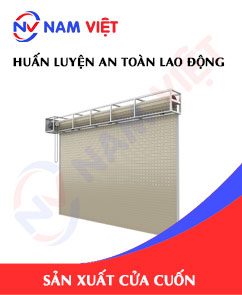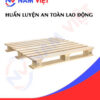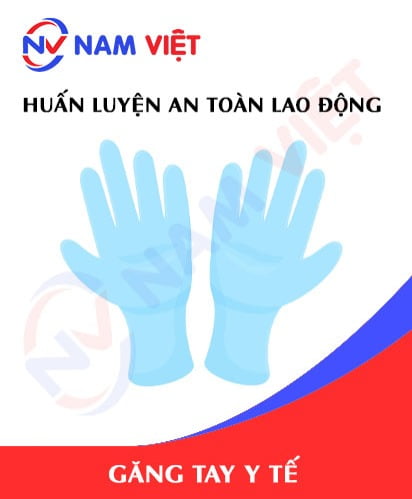Occupational Safety Training for Roller Shutter Manufacturing
99,000 ₫
Note: The above price is calculated for one person, and the price may fluctuate depending on the number of learners participating in the course and market movements. For more accurate pricing support, please refer to the price list or contact our consulting staff directly.
Occupational safety is an important issue in roller shutter manufacturing factories and needs to be addressed promptly to ensure the health and safety of workers and enhance the reputation of enterprises. The Occupational Safety Training course is one of the effective solutions to raise awareness on how to prevent workplace accidents for workers participating in roller shutter manufacturing.
Table of Contents
Toggle1. Overview of Roller Shutters
a. What are Roller Shutters?
Roller shutters are a type of door designed to open and close by rolling up or rolling down. They are commonly used in commercial buildings, shops, warehouses, and even in residential houses.
Roller shutters are usually made of hinges, panels, or metal sheets assembled into a vertical wall. When opened, the shutter rolls up or down around a horizontal or vertical axis. A motor system and control components are used to operate the opening and closing process of the shutter.
Roller shutters are often preferred due to their convenience and space-saving benefits. They can be operated remotely or by using a wall-mounted controller. Common types of roller shutters include aluminum shutters, steel shutters, and PVC shutters, available in various designs and colors to suit the architecture and style of houses or buildings.

b. Types of Machinery in Roller Shutter Manufacturing
Machinery involved in the roller shutter manufacturing process may include:
- Cutting machine: Used to cut materials such as aluminum, steel, or PVC into the required sizes and shapes for roller shutters.
- Press machine: Used to press material sheets together or attach necessary components such as hinges, locks, and other details.
- Welding machine: Used to weld metal parts of the roller shutter together, ensuring strength and tightness.
- Bending machine: Used to bend material sheets such as aluminum or steel into required shapes for roller shutters, such as cylinders, U-shapes, or triangles.
- Sanding machine: Used to smooth the surface of roller shutters and remove cracks or sharp edges.
- Painting machine: Automatic or manual painting machines are used to coat the roller shutter surface with desired colors and patterns.
- Computer Numerical Control (CNC) machine: Used for precision machining of parts and cutting holes on roller shutters.
Additionally, during the roller shutter manufacturing process, manual workers are involved in assembly, quality inspection, and finishing of roller shutter components.

c. Roller Shutter Manufacturing Enterprises in Vietnam
In Vietnam, there are many enterprises specializing in roller shutter manufacturing. Below are some well-known and popular enterprises in the roller shutter manufacturing industry in Vietnam:
- Thanh Vinh Manufacturing and Trading Company Limited: One of the leading enterprises in the field of roller shutter manufacturing and installation in Vietnam. Thanh Vinh provides aluminum shutters, steel shutters, and PVC shutters.
- Vu Anh Manufacturing and Trading Company Limited: Specializes in manufacturing and supplying aluminum shutters, steel shutters, and PVC shutters for domestic and export markets.
- An Phu Steel Sheet Manufacturing and Trading Company Limited: One of the major enterprises in steel roller shutter manufacturing in Vietnam. They supply high-quality steel shutters for commercial and residential projects.
- Pacific Roller Shutter Manufacturing and Import-Export Company Limited: Produces and supplies aluminum, steel, and PVC shutters for construction projects and individual customers.
- Duc Tai Manufacturing and Trading Company Limited: Specializes in aluminum and steel roller shutter manufacturing with diverse designs and colors to meet customer needs.
These are just a few examples of roller shutter manufacturing enterprises in Vietnam and do not include all companies in the industry. Customers should research and consult further before deciding on a roller shutter supplier.

d. Specific Jobs in Roller Shutter Manufacturing Factories
Group 1
- General directors, deputy general directors, department heads in roller shutter manufacturing factories.
Group 2
- Safety officers: manage factory safety, design safety procedures, supervise, and enforce employee compliance with safe work procedures.
Group 3
- Material fabrication and cutting: Workers use cutting machines to cut aluminum, steel, or PVC sheets into the required sizes and shapes for roller shutters.
- Machining and bending: Bending machines are used to shape aluminum or steel sheets into the required roller shutter forms.
- Welding and assembly: Workers use welding machines to weld metal parts of the roller shutter together, then assemble them into a complete shutter.
- Adjustment and inspection: Workers adjust and inspect the accuracy of parts and operating mechanisms of the shutter, ensuring smooth and reliable operation.
- Painting and finishing: Roller shutters may be painted or surface-finished with desired colors and patterns. Workers use painting machines or manual painting methods to ensure a durable and aesthetic finish.
- Packing and transportation: After completion, shutters are carefully packed to ensure safety during transport to customers.
Group 4
- Office, service, sales, and marketing jobs.
- Production management, quality management, human resource management, materials management, financial and accounting management.
- Design: Design engineers create technical drawings and 3D models of roller shutters, ensuring accuracy and aesthetics of products.
2. Overview of Occupational Safety Training for Roller Shutter Manufacturing
In this article, we focus on issues related to group 3, because group 3 is directly involved in the manufacturing process and faces the highest occupational safety risks. Refer to other groups here
a. What is Group 3 Occupational Safety Training?
- Group 3 occupational safety training consists of classes that provide awareness of accident prevention for workers.
- The occupational safety training course helps workers recognize and avoid hazards, thereby reducing the risks of workplace accidents.
REGISTER FOR OCCUPATIONAL SAFETY TRAINING SERVICE
b. Training Duration
Initial training duration for group 3
- Total training time is at least 24 hours, including test time.
- 8 hours of theory on occupational safety and hygiene law and policy system
- 8 hours of theory on basic knowledge of occupational safety and hygiene
- 4 hours of theory on specialized training content
- 2 hours of practice on specialized training content
- 2 hours of theory test at the end of the course
The occupational safety training center will schedule multiple training sessions depending on the availability of workers. Typically, there will be 6 training sessions, and the course will last 3 days, provided the manufacturing enterprise arranges continuous learning time.
Periodic training duration for group 3
- Before the occupational safety card expires, workers who want renewal must undergo periodic occupational safety training, with the periodic training duration being at least 50% of the initial training duration.
Explanation: The total periodic occupational safety training duration is at least 12 hours, including test time. After completing periodic training and passing the test, workers will be reissued and renewed with the occupational safety card.
c. Training Content
| No. | TRAINING CONTENT | TRAINING DURATION (HOURS) | |||
| Total | Including | ||||
| Theory | Practical | Test | |||
| I | Occupational safety and hygiene laws and policy system | 8 | 8 | 0 | 0 |
| 1 | Overview of the system of legal documents on occupational safety and hygiene. | 6 | 6 | ||
| 2 | System of occupational safety and hygiene standards and technical regulations. | 1 | 1 | ||
| 3 | Specific regulations of state management agencies on occupational safety and hygiene when constructing, expanding, or renovating works, facilities to manufacture, use, store, preserve, and inspect machinery, equipment, materials, and substances with strict occupational safety and hygiene requirements. | 1 | 1 | ||
| II | Basic knowledge of occupational safety and hygiene | 8 | 8 | 0 | 0 |
| 1 | Basic knowledge of hazardous and harmful factors in the workplace. | 4 | 4 | ||
| 2 | Methods to improve working conditions. | 1 | 1 | ||
| 3 | Safety culture in production and business. | 1 | 1 | ||
| 4 | Rights and obligations of employers and employees; occupational safety and hygiene policies and regimes for employees; functions and duties of the occupational safety and hygiene network. | 1 | 1 | ||
| 5 | Safety and hygiene rules, signs, and instructions; use of safety equipment and personal protective equipment; skills for first aid in occupational accidents; occupational disease prevention. | 1 | 1 | ||
| III | Specialized training content | 6 | 4 | 2 | 0 |
| Comprehensive knowledge of machinery, equipment, substances generating hazardous and harmful factors; analysis, assessment, risk management of occupational safety and hygiene; safe working procedures with machinery, equipment, and substances with strict occupational safety and hygiene requirements. | 6 | 4 | 2 | ||
| IV | Final occupational safety training test | 2 | 2 | 0 | 0 |
| Total | 24 | 22 | 2 | ||
See more training content of 6 groups
d. Occupational Safety Card
After completing the occupational safety training course and passing the test, workers will be issued an occupational safety card (also commonly called a group 3 occupational safety certificate).
The group 3 safety card will clearly show information such as: full name, date of birth, job, and specific working environment. It also includes training time, red seal, and signature confirming completion of the training course.
According to the regulations on safety card issuance stated in Clause 2, Article 24 of Decree 44/2016/ND-CP, it is divided into 2 cases:
- If the employer and the employee have a labor contract, then the employer must sign, stamp, and seal the occupational safety card for group 3 employees after they have completed the training course at an occupational safety training unit and passed the test.
- If the employee is a freelancer, seasonal worker, or does not have a labor contract, then the training unit must sign, stamp, and seal the occupational safety card for the employee after they have completed the training course and passed the test.

3. Identifying hazards affecting workers in roller shutter manufacturing
When manufacturing roller shutters, there are some potential hazards that may affect workers. Below are some common hazards in the roller shutter manufacturing process:
- Hazards from machinery and equipment: Workers may face dangers from automatic running machines or other technological equipment during manufacturing. This includes risks of collision, cutting, flying debris, crushing, pulling, and impact. To reduce these risks, it is necessary to comply with safety regulations, ensure that machines are regularly maintained, and workers are trained in workplace safety.
- Chemical hazards: During the roller shutter manufacturing process, materials and chemicals such as glue, paint, solvents, and cleaning agents may be used. Workers may be exposed to these substances through inhalation, skin contact, or ingestion. It is necessary to ensure that workers are provided with appropriate personal protective equipment, such as masks, gloves, chemical-resistant clothing, and safety glasses. In addition, safe management and storage of materials and chemicals are also very important.
- Noise hazards: The roller shutter manufacturing process may generate loud noise from machines and tools used. Prolonged loud noise can damage workers’ hearing. The use of ear protection and/or noise reduction devices is necessary to protect workers’ health.
- Hazards from lifting, moving, and installing materials: Roller shutters are usually large and heavy. During moving and installation, workers may face dangers from lifting, transporting, and assembling the shutters.
- Electrical hazards: If electrical equipment in the factory is not regularly maintained, not sufficiently insulated, or not waterproof, it will cause electrical hazards such as electric shocks for workers during manufacturing.

4. Common occupational accidents for workers in roller shutter manufacturing
There are some common types of occupational accidents in the roller shutter manufacturing process. Below are some common types of accidents that workers may encounter:
- Collision accidents: Including collisions with machinery, equipment, materials, or other objects during manufacturing. This can occur due to inattention, imbalance, or safety failures during movement, operation, or maintenance.
- Cutting and injury accidents: When working with cutting machines, welding machines, or other sharp tools, workers may suffer cuts, punctures, or injuries due to insufficient caution or improper use of equipment.
- Chemical poisoning: Roller shutter manufacturing may involve the use of materials, glue, paint, solvents, and cleaning agents that can cause poisoning if safety regulations are not followed, insufficient usage information is provided, or personal protective equipment is not used.
- Fall accidents from height: During installation or movement of roller shutters, workers may face hazards from falling from height. This can happen when working on ladders, scaffolding, or other unsafe positions.
- Accidents from engines and electrical equipment: Roller shutter manufacturing requires the use of engines and electrical equipment. Workers may face hazards from accidents such as electric shock, fire, or equipment failure causing explosions.
5. Safety measures in roller shutter manufacturing
When participating in roller shutter manufacturing, there are some important safety measures to ensure worker safety. Below are some safety measures that must be followed:
- Ensure safety training: Training and educating workers on safety regulations, work procedures, and the use of personal protective equipment is very important. Workers need to be instructed on how to safely and effectively use tools, machinery, and equipment.
- Use personal protective equipment (PPE): Provide and ensure full use of personal protective equipment such as helmets, safety glasses, masks, gloves, and safety shoes. PPE helps protect workers from risks of collision, cutting, explosion, and toxic substances.
- Inspect and maintain machinery: Conduct regular inspections and maintenance of machines to ensure they operate safely and effectively. Ensure that machinery is operated according to manufacturer instructions and free of technical faults.
- Manage materials and chemicals: Store and use materials and chemicals according to safety regulations. Ensure that materials and chemicals are properly preserved and prevent risks of explosion, fire, or environmental pollution.
- Comply with safe working procedures: Ensure that safe working procedures are strictly followed. This includes compliance with regulations on how to work with machines, tools, materials, and safe operating rules.
- Periodically organize occupational environment monitoring in factories, collect and analyze harmful factors for workers, thereby adjusting and reducing risks to prevent occupational diseases for them.
6. Benefits of occupational safety training in roller shutter manufacturing
An Toan Nam Viet provides businesses with great benefits after completing occupational safety training courses in accordance with Decree 44/2016/ND – CP on occupational safety and hygiene for companies, factories, and enterprises.
- Workers can identify potential risks of occupational accidents and take preventive measures to avoid accidents.
- Businesses can establish preventive measures against risks in manufacturing, operation, and maintenance processes.
- Minimize costs when safety risks occur in labor.
- Uninterrupted manufacturing processes will help increase labor productivity and product quality.
- Comply with legal regulations on occupational safety and avoid legal risks.
- Create credibility and professionalism in all aspects, thereby enhancing the brand value of businesses.
The training courses of Nam Viet are solutions to prevent external factors that may affect each individual, so that they can avoid dangers that may lead to injury or even death.
REGISTER FOR OCCUPATIONAL SAFETY TRAINING SERVICE
7. Customer feedback after completing occupational safety training in roller shutter manufacturing
An Toan Nam Viet has many years of experience in the mission of accompanying many businesses in Vietnam in general and in the southern provinces in particular. That responsibility for Nam Viet is extremely valuable, which is why Nam Viet’s Occupational Safety Training work is always increasingly professional. The driving force for An Toan Nam Viet to grow to this day comes from positive feedback as well as suggestions from businesses. Below are the feedback from our partners that we have served.
1 review for Occupational Safety Training for Roller Shutter Manufacturing
No comments yet












namchinh.haiphong341
Dịch vụ huấn luyện an toàn lao động rất tốt nhé, giảng viên dạy rất sinh động dễ hiểu!